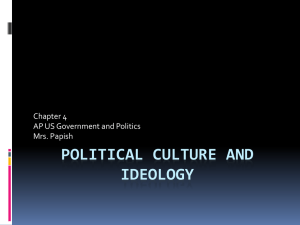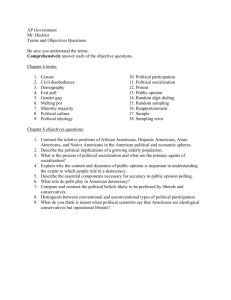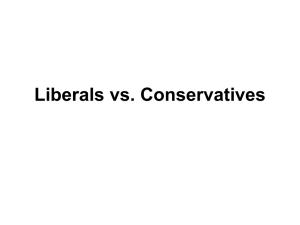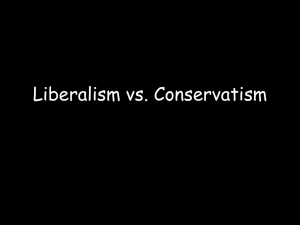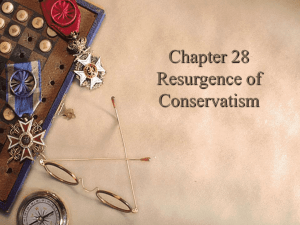Psychology in Politics
advertisement
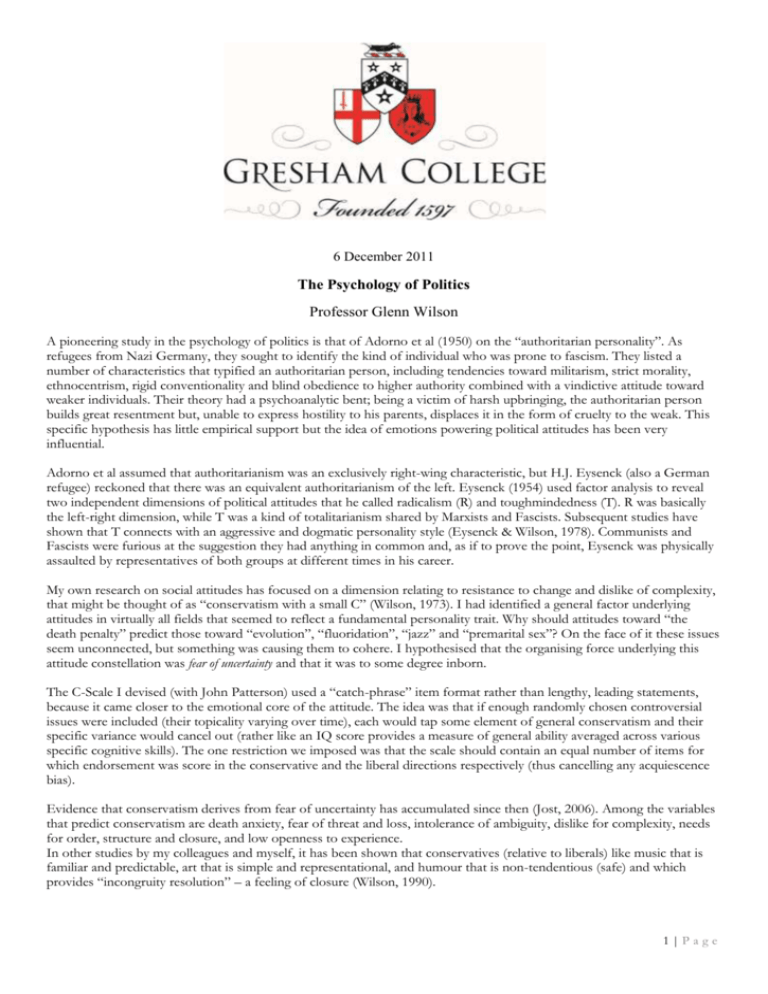
6 December 2011 The Psychology of Politics Professor Glenn Wilson A pioneering study in the psychology of politics is that of Adorno et al (1950) on the “authoritarian personality”. As refugees from Nazi Germany, they sought to identify the kind of individual who was prone to fascism. They listed a number of characteristics that typified an authoritarian person, including tendencies toward militarism, strict morality, ethnocentrism, rigid conventionality and blind obedience to higher authority combined with a vindictive attitude toward weaker individuals. Their theory had a psychoanalytic bent; being a victim of harsh upbringing, the authoritarian person builds great resentment but, unable to express hostility to his parents, displaces it in the form of cruelty to the weak. This specific hypothesis has little empirical support but the idea of emotions powering political attitudes has been very influential. Adorno et al assumed that authoritarianism was an exclusively right-wing characteristic, but H.J. Eysenck (also a German refugee) reckoned that there was an equivalent authoritarianism of the left. Eysenck (1954) used factor analysis to reveal two independent dimensions of political attitudes that he called radicalism (R) and toughmindedness (T). R was basically the left-right dimension, while T was a kind of totalitarianism shared by Marxists and Fascists. Subsequent studies have shown that T connects with an aggressive and dogmatic personality style (Eysenck & Wilson, 1978). Communists and Fascists were furious at the suggestion they had anything in common and, as if to prove the point, Eysenck was physically assaulted by representatives of both groups at different times in his career. My own research on social attitudes has focused on a dimension relating to resistance to change and dislike of complexity, that might be thought of as “conservatism with a small C” (Wilson, 1973). I had identified a general factor underlying attitudes in virtually all fields that seemed to reflect a fundamental personality trait. Why should attitudes toward “the death penalty” predict those toward “evolution”, “fluoridation”, “jazz” and “premarital sex”? On the face of it these issues seem unconnected, but something was causing them to cohere. I hypothesised that the organising force underlying this attitude constellation was fear of uncertainty and that it was to some degree inborn. The C-Scale I devised (with John Patterson) used a “catch-phrase” item format rather than lengthy, leading statements, because it came closer to the emotional core of the attitude. The idea was that if enough randomly chosen controversial issues were included (their topicality varying over time), each would tap some element of general conservatism and their specific variance would cancel out (rather like an IQ score provides a measure of general ability averaged across various specific cognitive skills). The one restriction we imposed was that the scale should contain an equal number of items for which endorsement was score in the conservative and the liberal directions respectively (thus cancelling any acquiescence bias). Evidence that conservatism derives from fear of uncertainty has accumulated since then (Jost, 2006). Among the variables that predict conservatism are death anxiety, fear of threat and loss, intolerance of ambiguity, dislike for complexity, needs for order, structure and closure, and low openness to experience. In other studies by my colleagues and myself, it has been shown that conservatives (relative to liberals) like music that is familiar and predictable, art that is simple and representational, and humour that is non-tendentious (safe) and which provides “incongruity resolution” – a feeling of closure (Wilson, 1990). 1|Page Further support for the idea that conservative attitudes derive from fearful emotions comes from a study of physiological responses to threat signals. Oxley et al (2008) measured startle reflexes (eyeblink magnitudes) to sudden, loud noises and increases in skin conductance to threatening visual images (e.g. spiders and open wounds), comparing those who were conservative and liberal with respect to 14 issues. Issues chosen related to “protection of the social order” and included the death penalty, abortion, premarital sex, pornography, Biblical truth, patriotism, military expenditure and gun control (economic issues were excluded). Conservatives showed significantly higher fear responses to the threat signals on both indicators. The authors interpret this as suggesting that political attitudes and responses to threat both derive from neural activity patterns, very likely those surrounding the amygdala. Political conservatism relates to disgust sensitivity, indexed by squeamishness towards insects, insanitary conditions, foul odours, etc (Inbar et al, 2011). This result holds up internationally and applies particularly to issues relating to interpersonal contamination. Other studies found that reminders of cleanliness (e.g., notices about the importance of washing hands) shift attitudes in a conservative direction (Helzer & Pizzaro, 2011). Apparently, the “fearfulness” of conservatives goes beyond uncertainty to concern about what they might catch from others. Differences between self-described liberals and conservatives have been observed directly in the brain. Amodio et al (2007) measured event-related potentials on the scalp in a “go/no-go” paradigm. Two components suggested greater conflict monitoring in liberals: (1) the response-locked error-related negativity (ERN), which reflects conflict between a habitual tendency and an alternative, and (2) the “no-go” N2 component, which reflects conflict monitoring activity associated with successful inhibition on “no-go” trials. These results were interpreted as suggesting that liberals are more open to changing their habits when the situation calls for it. Using structural MRI, Kanai et al (2011) found a greater amount of gray matter in the anterior cingulate cortex of liberals and a larger right amygdala in conservatives. The former result fits with Amodio et al in suggesting greater self-regulatory conflict monitoring in liberals, while the second supports the idea of fear and disgust susceptibility in conservatives. Kanai et al say that brain structures predict political leanings with 72% accuracy but caution that the direction of cause and effect is not known; developing cognitive styles could lead to differing neural structures as well as be influenced by them. The idea that social and political attitudes could be genetically transmitted flies in the face of the common wisdom that they are learned within the family. However, there is insurmountable evidence that genetics contribute powerfully to attitudes (Alford et al, 2005; Hatemi eta l, 2011). This is seen most obviously in the fact that identical twins are more alike in attitudes than non-identical twins. After correction for assortative mating between the parents (the fact that people marry others with similar attitudes), the heritability for conservatism comes out at around 50%. Two other findings are of interest: (1) the more heritable the C-Scale item, the more it evokes a “gut reaction” as evidenced by speed of response and resistance to change (Tesser, 1993). (2) The shared family environment contributes little to attitudes; the environmental effect is almost entirely non-shared. This would account for the fact that some children follow the family line while others do not (we inherit differences from our parents as well as similarities, even if our upbringing is much the same). Note, however, that genetics plays less of a part in determining voting behaviour; here the family environment is more influential. Ideology is no doubt multigenetic, but one particular gene has been implicated. This is a gene previously shown to connect with novelty-seeking behaviour: the dopamine receptor D4 gene (DRD4). Settle et al (2010) report that in adolescents with the 7R variant, those with more friends tend to be more liberal; for those without DRD4-7R there is no such association. This is interesting because it highlights gene-environment interaction. The authors suggest that those with a genetic predisposition become more liberal only when embedded in a social context that provides them with multiple points of view. Correlations between personality and ideology are consistent with the uncertainty hypothesis. Using the “Big 5” personality classification, De Neve (2011) found that Openness to experience (curiosity, imagination and risk-taking) went with self-rated “liberalism”, while Conscientiousness (responsibility, order and self-control) went with “conservatism”. De Neve also found that childhood trauma (self-recalled verbal, physical and sexual abuse) contributed (to a much lesser degree) to the likelihood of a liberal attitude pattern. It is not clear why this would be so; perhaps being open increases the likelihood of abuse, or perhaps the experience of being abused raises empathy for those who are disadvantaged. Note that this finding seems counter to the Adorno et al theory that childhood abuse results in authoritarianism. 2|Page Which is better, liberal or conservative? According to Ambrose Pierce, “conservatives are enamoured of existing evils, while liberals want to replace them with others”. Despite their frequent belief that the other is irrational, there is no striking difference in intelligence between liberals and conservatives. Stankov (2009) reports that liberals have higher cognitive ability but the difference is small (Lapsley & Enright, 1979; Khan, 2008/9). Nor is there any difference between liberals and conservatives in general neuroticism, despite the apparent susceptibility of conservatives to threat and disgust (Jost et al 2003). Hirsh et al (2010) argue that liberals and conservatives are both value driven but the order of priority of the values is different. For liberals, openness, compassion and equality are uppermost, while conservatives are more concerned about order, tradition and reliability. These values are deeply embedded in a person’s biology and genetic heritage. The fact that these orientations are so persistent suggests that each has evolutionary costs and benefits and both probably contribute to an effective balance in society. What is the connection between “small c” conservatism and voting preferences? Fear of uncertainty might lead some to seek to preserve what is established and to prefer continuity rather than change, so a party that states this as an aim should attract people with conservative personalities. Indeed, in the Italian context, voting choices have been shown to be influenced by “need for closure” (a personality trait like conservatism) – those with a greater need for closure tending to vote for more right-wing parties (Chirumbolo & Leone, 2008). This could explain why disadvantaged people sometimes embrace right-wing political parties (what might be dubbed the “Alf Garnett effect”). Such parties offer continuity and predictability, thus controlling anxiety. Advantaged people are more likely to gravitate towards right-wing politics for reasons of self-interest or social dominance (Jost et al, 2003). Age is also a factor because, as people get older, they become less exploratory and are likely to have acquired more to conserve. For many voters the central issue is that of wealth distribution. David Frost once remarked that “a conservative is someone who demands a square deal for the rich”, while G. B. Shaw noted that “a government that robs Peter to pay Paul can always count on the support of Paul”. Those who have wealth believe they have earned it, or otherwise deserve it, and therefore prefer it is not redistributed. Those who have little deplore the “greed” of the rich and feel it should be shared more equally. Against this (class-tied) issue, other controversies may pale into insignificance, particularly in times of economic difficulty. It is not therefore surprising that personality maps poorly onto political allegiance. When it comes to understanding the emergence of dictators the liberal-conservative dimension is not uppermost. Here we need to return to Eysenck’s “toughmindedness”, a dimension of politics that is independent of left versus right. This trait is characterised by aggression and intolerance and it seems to account for the appeal of extreme parties of any leaning. Dictators usually have some degree of charisma that enables them to garner support from individuals and populations that harbour some degree of anger and resentment. It follows that a dictator is not solely responsible for his policies; some blame must attach to those that support his ascendency. Of necessity, analysis of the personality of dictators is done by remote assessment, nevertheless, but there is much agreement among the experts. Coolidge and Segal (2009) compared the characteristics of Adolf Hitler, Saddam Hussein and Kim Jong-Il, concluding that all three displayed antisocial, narcissistic, schizoid and schizotypal personality disorders, sadism and paranoia. Fallon (2011) concurs, noting that dictators share many traits with clinical psychopaths. They are usually charming, charismatic and intelligent, brimming with self-confidence and independence, self-absorbed, masterful liars, compassionless, often sadistic, and with a boundless appetite for sex and power. Their key principle is often that advised by Machiavelli in The Prince (1532): “It is safer to be feared than loved.” It is said that “power corrupts” and there is considerable evidence this is the case. In the famous Stanford Prison Experiment (1971) students were randomly assigned as “prisoners” or “guards” in a makeshift prison in the basement of Stanford University. So quickly did the guards become and abusive and cruel and the prisoners passive that the experiment was terminated in six days (Zimbardo, 2007). In a series of experiments on the effects of giving people a sense of power, Galinsky et al (2008) and Van Cleef et al (2008) asked subjects to recall an incident from their past when they had experienced high power; others were asked to recall lowpower situations. Those primed to feel powerful were less empathic (e.g., as indicated by ability to recognise emotion in the faces of others), less compassionate (controlling emotions when confronted with the suffering of others) and more self-oriented (as indicated by drawing an “E” on their forehead that would appear backwards to an outside observer). The authors conclude that power makes people arrogant and reduces their capacity to comprehend how others see, think and feel. 3|Page Fast et al (2009) found that empowered people were more likely to believe they had control even in random activities such as determining the outcome of a dice throw. This proneness to “illusory control” in powerful people might have benefits to a leader in terms of self-confidence but it can lead to poor choices and may be one of the ways in which power often leads to its own demise. Lammers & Stapel (2011) demonstrated the dehumanising effect of power. Subjects who naturally felt powerful were more derogatory about the inhabitants of a fictional South American country (“Aurelia”), viewing them, for example, as less civilised and more childish. Some were then primed to feel more powerful still; this made them more inclined to back a plan to clear people from slums against their will. Finally, students were asked role-play either a senior surgeon, a junior surgeon, or a nurse; those who ranked higher chose treatments that were more painful but more effective. The authors note that dehumanisation is not always bad; it can lead to abuse but may also help in the making of tough but necessary decisions. Keltner (2010) argues that powerful people feel less need to make alliances with others, leading to what he calls the “paradox of power”. The qualities that facilitate the rise to power (social intelligence, skill in negotiation, cooperation and responsibility) are the very ones that decline once power has been obtained. Once in positions of power people act more selfishly, impulsively and aggressively. So if dictators are not necessarily psychopaths to begin with they tend to become so progressively over time. This is a warning we should heed. Our best defence against the rise of dictators is a democratic constitution in which the leaders have fixed terms, thus preventing them from becoming so entrenched that Keltner’s paradox has time to operate. 4|Page References Adorno, T. et al (1950) The Authoritarian Personality. New York: Harper. Alford, J. (2005) Are political orientations genetically transmitted? American Political Science Review, 99, 153-167. Amodio, D.M. et al (2007) Neurocognitive correlates of liberalism and conservatism. Nature Neuroscience, 10, 1246- 1247. Chirumbolo, A. & Leone, L (2008) Individual differences in need for closure and voting behaviour. Personality and Indiviudal Differences, 44, 1279-1288. Coolidge, F.L. & Segal, D.L. (2009) Is Kim Jong-il like Saddam Hussein and Adolf Hitler? A personality disorder evaluation. Behavioural Sciences of Terrorism and Political Aggression, 3, 195-202. De Neve, J. (2011) Personality, childhood experience and political ideology. (available online). Eysenck, H.J. (1954) The Psychology of Politics. London: Routledge & Kegan Paul. Eysenck, H.J. & Wilson, G.D. (1978) The Psychological Basis of Ideology. Lancaster; MTP Press. Fallon, J. (2011) The mind of a dictator. Psychology Today, June 9. Fast, N. et al (2009) Illusory control: a generative force behind power’s far-reaching effects. Psychological Science, 20, 502-508. Galinski, A.D. et al (2006) Power and perspectives not taken. Psychological Science, 12, 1068-1074. Hatemi, P.K. et al (2011) Integrating social science and genetics: News from the political front. Biodemography and Social Biology, 57, 67-87. Helzer, E.G. & Pizarro, D.A. (2011) Dirty liberals! Reminders of physical cleanliness influence moral and political attitudes. Psychological Science (online). Hirsh, J.B. et al (2010) Compassionate liberals and polite conservatives: Associations of Aggreeableness with political ideology and moral values. Personality and Social Psychology Bulletin, 36, 655. Inbar, Y. et al (2011) Disgust sensitivity, political conservatism and voting. Social, Psychological and Personality Science (online). Jost, J.T. (2006) The end of the end of ideology. American Psychologist. 61, 651-670. Jost, J.T. et al (2003) Political conservatism as motivated social cognition. Psychological Bulletin, 129, 339-375. Kanai, R. et al (2011) Political orientations are correlated with brain structure in young adults. Current Biology, 21, 677-680. Keltner, D. (2010) The power paradox. Greater Good, UC Berkeley Magazine, Winter 2007-8. (online). Khan, R. (2008/9) Conservatives are as smart as liberals. Discover Magazine, 2008/9 (online). Lammers, J. & Stapel, D. (2011) Power increases dehumanisation. Group Processes and Intergroup Relations, 14, 113-126. Lapsley, D.K. & Enright, R.D. (1979) The effects of social desirability, intelligence and milieu on an American validation of the Conservatism Scale. Journal of Social Psychology, 107, (online). Machiavelli, N. (1532) The Prince. Florence: Blado d’Asola. Oxley, D.R. et al (2008) Political attitudes vary with physiogical traits. Science, September 19, 1667-1670. Settle, J.E. et al (2010) Friendships moderate an association between a dopamine gene variant and political ideology. The Journal of Politics, 72, 1189-1198. Stankov, L. (2009) Conservatism and cognitive ability. Intelligence, 37, 294-304. Tesser, A. (1993) The importance of heritability in psychological research: The case of attitudes. Psychological Review, 100, 129-142. Van Cleef. G.A. et al (2008) Power, distress and compassion: Turning a blind eye to the suffering of others. Psychological Science, 19, 1315-1322. Wilson, G.D. (1973) The Psychology of Converatism. London: Academic Press. Wilson, G.D. (1990) Ideology and humour preferences. International Political Science Review, 11, 461-472. Zimbardo, P. (2007) The Lucifer Effect: Understanding how good people turn evil. New York: Random House. ©Professor Glen Wilson, Gresham College 2011 5|Page
